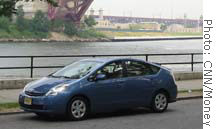NEW YORK (CNN/Money) - I really tried to avoid getting sucked in, but after four days, it was too much to resist. I had insisted I would drive like a New Yorker. But, finally, I let a car soften me. And what did that get me?

An extra five miles to the gallon.
I recently spent five days with a Toyota Prius, courtesy of Toyota. It surprised me. I had always read, and written, that the car's gas mileage was better in stop-and-go city driving than it was in steady highway cruising.
Perhaps it is, but not in New York City's version of city driving.
The Prius was clearly in its element in the low-speed, dart-and-weave grind of urban traffic. The egg-shaped sky-blue metallic car looked like it would be the vehicle of choice for the Easter Bunny, but its stubby nose was perfect for swinging around double-parked delivery vans. Parallel parking was an absolute breeze.
In terms of fuel mileage, though, the Prius's performance on my daily commute was surprising. It was good, but far from what I'd expected.
Tricks of the trade
One of the Prius's most important fuel-saving tools is a computer screen in the center of the dashboard.
When it's not displaying climate or stereo controls, it shows a continuous readout of the car's fuel-saving performance. I could choose either a simple bar graph or a dynamic display showing the moment-by-moment activity of the car's electric and gasoline powerplants, along with a readout of its fuel efficiency at every moment.
| Related story
|

|
|
|
|
On a 20-mile weekend test drive, I was able to mix things up a bit -- a few stretches of highway with surface roads mixed in -- and the car averaged about 45 miles to the gallon. That was about what I'd expected. The EPA estimate for this car is 55 miles per gallon in combined city and highway driving. Since no car really achieves the EPA estimated mileage, 45 miles per gallon seemed about right.
What was odd was that its city-vs.-highway gas mileage performance was what one would expect with any car. The EPA estimate gives a higher mileage number, 60, in city driving and a lower one, 51, for highway driving.
On the highway, I frequently saw fuel mileage numbers in the 60s flash by. During my daily commute to work, which involved no highway driving at all and took me straight through the congested heart of mid-town Manhattan, I was averaging 30 miles to the gallon. By the standards of most cars, 30 mpg in city driving would be considered outstanding.
In this case, I wondered what I was doing wrong.
How it works
The Prius uses both a 76 horsepower gasoline engine and a 67 horsepower electric motor. Some of the power for the gasoline engine is used to charge the battery for the electric motor. (Toyota rates total horsepower output for the hybrid system at 110.) When the car is stopped, even for a moment, the gasoline engine shuts off altogether. It doesn't come back on until the car is rolling along again.
 |
|
| 2004 Toyota Prius in Queens, New York. |
At very low speeds -- like in a traffic jam -- the car can putter along with just the electric motor. At higher speeds, the electric motor acts sort of like a turbocharger, providing a boost for a gasoline engine that, ordinarily, would be out of its league powering a vehicle of any real size.
The key to winning the fuel mileage game, I quickly figured out, was trying to keep only one powerplant at a time in operation as often as possible. It's not easy. Still, in my last cross-town drive, going as gently as I could without causing a road rage incident, the best I managed was an improvement to 35 mpg.
A Toyota spokesperson later theorized that the Prius might have gotten better mileage in genuine gridlock. My commute consisted more of high-speed dashes followed by long, still waits. Not the best fuel economy scenario for any car, including the Prius.
Inside the egg
Fuel economy aside, the Prius is a far better car than its emphasis on fuel economy might suggest. Certainly, no one will confuse it with a performance car, but the light weight Prius never felt like a laggard. Its tall profile and soft suspension give the car some serious wobbles in hard cornering or on worked-over pavement, though. Inside, the car is surprisingly roomy with space for four adults and their stuff.
The Prius's array of deliberate oddities is aimed squarely at the heart of a techno-geek like me. There is no reason the Prius couldn't start with the turn of a key like any other car. Instead, the driver shoves a small plastic box into a rectangular hole in the dashboard and presses a start button designed to resemble a computer's power button.
But it sure makes starting the car in the morning much more entertaining. So does putting the car in gear by flipping a large, stubby toggle near the steering wheel rather than pulling a more normal gear selector.
One thing the Prius really didn't deliver during my test drives was a crowd. I was ready and able to answer questions from curious strangers wherever I stopped. None came. As far as I could tell, no one even gave the car a second look. I was barely even able to detect the occasional first glance.
Perhaps Toyota's public relations campaign has worked so well that curiosity has simply vanished. If you're on one of those months-long waiting lists to buy a Prius, don't worry. The car is still pretty cool and it probably still will be when you get yours.
But it's not going to get you any dates.

|

